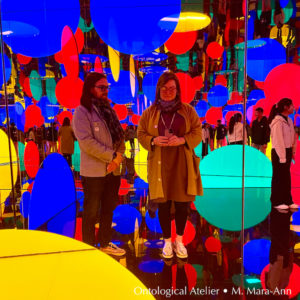Time and technology
 I recently viewed Yayoi Kusama’s “Infinite Love” at SFMOMA this winter. The first time was last December and then again this February. Both times I visited with my husband with whom I have this incredible harmony of attention where we move through exhibits in an equal measure of pace. Often, the people you’re with move more rapidly or more slowly, but rarely at your same pace. We do, and I’ve always loved this about us since our first visit in the 90’s.
I recently viewed Yayoi Kusama’s “Infinite Love” at SFMOMA this winter. The first time was last December and then again this February. Both times I visited with my husband with whom I have this incredible harmony of attention where we move through exhibits in an equal measure of pace. Often, the people you’re with move more rapidly or more slowly, but rarely at your same pace. We do, and I’ve always loved this about us since our first visit in the 90’s.
Smartphones didn’t exist back then and most everyone was still using film cameras. Fast forward a decade, and smartphones became ubiquitous. I would then occasionally take a photo at an exhibition, as a visual note for later. Then, as smartphones became more advanced and social media blossomed, I began taking more and more photos not only as notes, but to share online.
Something began to shift
I began feeling less fulfilled during my museum visits. Was it a natural shift after so many years, or perhaps the programming changed? But then, during this visit, something occurred to me. Maybe I wasn’t paying attention in the same way.
In December, when I entered the first infinity mirror room, “Dreaming of Earth’s Sphericity,” I automatically pulled out my smartphone and began taking photos. It’s a small space, and they only give you two minutes to explore before being ushered out for the next group. I had to capture it. The installation was amazing, but I wondered if I missed the experience while taking photos.
We returned a second time in February, and I made an intention to not touch my smartphone and just “be present” inside the infinity mirror room. There it was! That beautiful quality of attention, presence, and satisfaction, like before. Incredible. What else in my life was being mediated by my smartphone that might be better enjoyed without?! Attention really does matter.
.
